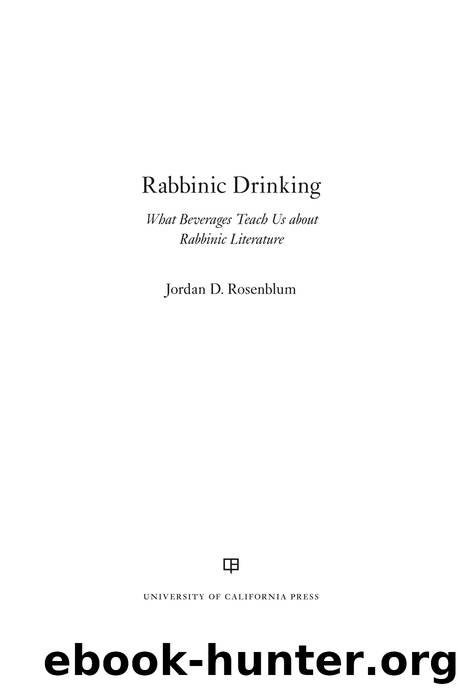Rabbinic Drinking: What Beverages Teach Us about Rabbinic Literature by Jordan D. Rosenblum

Author:Jordan D. Rosenblum
Language: eng
Format: epub
ISBN: 9780520300422
Publisher: University of California Press
HOW TO OFFER A RABBINIC TOAST
A fascinating final case study of the theme of symbolic inversion and illicit religious practice is the curious rabbinic category of “the ways of the Amorites” (Hebrew darkhei ha-’emori). Noted briefly in the Mishnah (see m. Shabbat 6:10; m. Hullin 4:7), a long series of such practices appears in t. Shabbat 6–7. To offer a few of the myriad examples found in t. Shabbat 6–7:
(6:1) What practices constitute “the ways of the Amorites”? . . .
(6:2) He who strikes the hip, claps hands, and dances before a flame, behold, these are the ways of the Amorites . . . .
(6:7) He who says: “Eat this date [or] this lettuce, that you should remember me by it”; . . . “Sit on a broom, so that you should dream”; “Do not sit on a broom, so that you should not dream”; behold, these are the ways of the Amorites . . . .
(6:11) He who pours out water into public streets, and says, “Here it is!” behold, these are the ways of the Amorites. If he did so [to warn] those who pass by on the street, behold, this is permitted. . . .
(6:14) She who shouts at an oven, so that the bread should not fall; and she who puts charms into the handle of a pot, so that it should not boil over, behold, these are the ways of the Amorites. But she may put chips of mulberry [wood] or glass into a pot, so that it should boil more quickly; but the sages say: She should not do so with glass [chips], because of mortal danger. . . .
(7:5) He who says, “Healing!” [when someone sneezes], behold, these are the ways of the Amorites. Rabbi Elazar bey Rabbi Zadoq says: one does not say “Healing!” because it interrupts Torah study. The members of the household of Rabban Gamaliel would not say “Healing!” because of the ways of the Amorites.
A variety of practices, from dancing to saying “Gesundheit!” when someone sneezes, constitute “the ways of the Amorites.” This text “offers a kaleidoscope of practices that lack a clear common denominator or an obvious organizing principle” (Berkowitz 2014, 96). A few points deserve mentioning. First, the verbs that appear throughout it are a mixture of masculine and feminine—meaning that they refer to both male and female agents. “The practices mentioned here are surprisingly gender-balanced, in contrast to much of the material on magic and superstition (including rabbinic) that associates them with women” (Berkowitz 2014 97n57). We should not, however, push this observation too far. For example, one of the female-gendered verbs refers to a woman putting charms into a pot handle in order to assure that its contents do not boil over (t. Shabbat 6:14). This serves to reinforce an association between women and magic, although male verbs refer to other magical practices.
Second, what precisely constitutes “the ways of the Amorites” is debated. To return to the previous example, while putting “charms” (Hebrew qesamin) into a pot handle is deemed one of “the ways of the Amorites,” putting in “chips” (Hebrew
Download
This site does not store any files on its server. We only index and link to content provided by other sites. Please contact the content providers to delete copyright contents if any and email us, we'll remove relevant links or contents immediately.
| Hebrew Bible (Old Testament) | Talmud |
| Torah | Zohar |
Man's Search for Meaning by Viktor E. Frankl(2261)
The Secret Power of Speaking God's Word by Joyce Meyer(2255)
Mckeown, Greg - Essentialism: The Disciplined Pursuit of Less by Mckeown Greg(2115)
MOSES THE EGYPTIAN by Jan Assmann(1974)
Unbound by Arlene Stein(1944)
Devil, The by Almond Philip C(1903)
The Complete Dead Sea Scrolls in English (7th Edition) (Penguin Classics) by Geza Vermes(1844)
I Capture the Castle by Dodie Smith(1574)
Schindler's Ark by Thomas Keneally(1516)
The Invisible Wall by Harry Bernstein(1460)
The Gnostic Gospel of St. Thomas by Tau Malachi(1414)
The Bible Doesn't Say That by Dr. Joel M. Hoffman(1372)
The Secret Doctrine of the Kabbalah by Leonora Leet(1269)
The Jewish State by Theodor Herzl(1252)
The Book of Separation by Tova Mirvis(1225)
A History of the Jews by Max I. Dimont(1210)
The Dead Sea Scrolls Bible by Martin G. Abegg(1200)
Political Theology by Carl Schmitt(1189)
Oy!: The Ultimate Book of Jewish Jokes by David Minkoff(1105)
